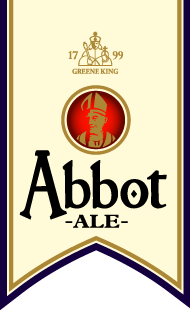Recipe: Abbots Special Bitter (1st Pass)
This recipe and process can be found here. Recipe feed for this pass can be found here.
Abbots Special Bitter is my first attempt at creating one of my wife’s favorite British Ales, Greene King Abbot Ale. She describes the ale as “smooth with a nice hint of apples”. It is this hint of fruit we will try to recreate in this classic Extra Special/Strong Bitter classed English Pale Ale.
Greene King Abbot Ale is steeped in history. Brewed in the old English town of Bury St Edmunds in the heart of Suffolk, the brewery sits along side the historic ruins of the old “Great Abbey” where, according the Doomsday Book, the local Abbot hired “cerevisiarii” or ale brewers as servants over 1000 years ago. The ale is still made from water drawn from the chalk heavy wells used all those years ago.
According to the Greene King web site the ale contains no wheat, is made from malted barley, is 5.0% ABV, and uses finings to clear the ale. On the brewing process page they claim to use Fuggles and Challenger hops.
Next stop was to check the The Real Ale Almanac by Roger Protz
. This is the bible of Real Ales covering every ale in the British Isles. The book provides tasting notes, descriptions of the brewery and its process, water source and ingredients (where available). From the almanac we get Pale Malt, Amber Malt, Crystal and the use of cane sugar. We also get an IBU of 30 and OG of 1048 and 90 min boil time. I could find nothing on SRM so I did some hands on research and purchased a can of draft Abbot Ale from the local Blanchards. I observed a copper to light brown colour, an SRM of approx 12-13. Not exact science I know, but it was a fun piece of research to carry out. It is often necessary to make sacrifices for ones research.
Finally I inputted all these variables into Hopville.com and played around with the mix of quantities until I came up with something near to the constraints provided above.
Base Malt: I replaced the Pale base malt with Light DME. Nuff said. I used a little cane sugar (as stated in the alamanc to bring the OG to 1050 and get the final ABV as near 5.0% as I could).
Specialty Grains: This proved difficult. We need to get the colour to around an SRM 13 and give a strong malt flavour to balance the moderately bitter 30 IBU. The almanac called for Amber and Crystal malt. To give colour without adding to the OG I used an Crystal 80 and then made up the ABV with Amber. The Crystal 80L should provide a moderate caramel flavour.
Hops: Given the higher Alpha % I went with Challenger as the bitterness hop and Fuggles as the aroma and used the quantities required to bring the IBU to approx 30.
Yeast: This is guess work. We want a yeast that provides fruity esters (for the apple taste) and a high attenuation to get a 5.0 ABV from an OG of 1050. I like to use the liquid yeasts with yeast starters so checked out the current strains available from Wyeast and White Labs. We also know they use finings, used to brighten an ale and remove yeast and proteins left behind from the primary fermentation. This would hint to the brewer using a yeast with low to medium flocculation as finings are not typically required when using high flocculating yeast.
Abbots Special Bitter (BJCP Beer Style: Extra Special/Strong Bitter, category: English Pale Ale)
- 5 Gallon, 90 min boil
- OG 1050, FG 1012
- 5.0% ABV
- 30 IBU
- 13° SRM
- Ready to drink in 6-7 weeks
Base Malt and Fermentables:
- 4 lbs 12 oz Light Dry Malt Extract (90 mins)
Specialty Grains:
- 12 oz Amber Malt
- 8 oz English Crystal 80L
Hops
- Bittering Hop – 1.25 oz Challenger (90 mins)
- Aroma Hop – 1 oz English Fuggles (10 mins)
Other Additions
- 1 tsp Irish Moss (30 mins)
- 2 oz Cane Sugar (after boil is complete)
Process
- Please follow the process guidelines outlined in my post here. You will require all the equipment specified here.
- Primary Fermentation: 5-7 days at 65-75°
- Secondary Fermentation: 2 weeks at 55° (if you can otherwise just 5-7 days in the same location as the primary)
- Prime and store in the bottle for at least 2 weeks before consuming
- Peak flavour will be reached after 4 weeks in the bottle

Pingback: British Brewer » Blog Archive » On Tap (13th Dec 2009)()
Pingback: British Brewer » Blog Archive » Recipe update()
Pingback: British Brewer » Blog Archive » On Tap (Mar 29th 2010)… plus a small recipe I made up()